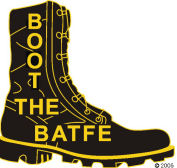

Gun Bans No Longer Enough;
Now They Want to Ban Gun Information
![]()
By Kurt Hofmann, May 13th 2015
JPFO writer contributor, © 2015.

Image, Oleg Volk
 In a lawsuit filed by the Second Amendment Foundation a week ago, the group is challenging the State Department's claimed power to ban the dissemination of data that the regime finds dangerous. This stems from the State Department's insistence that in releasing the CAD (Computer Aided Design) files for using 3-D printers to make operable firearms from plastic, the innovators and liberty advocates of Defense Distributed violated the International Traffic in Arms law.
In a lawsuit filed by the Second Amendment Foundation a week ago, the group is challenging the State Department's claimed power to ban the dissemination of data that the regime finds dangerous. This stems from the State Department's insistence that in releasing the CAD (Computer Aided Design) files for using 3-D printers to make operable firearms from plastic, the innovators and liberty advocates of Defense Distributed violated the International Traffic in Arms law.
 That would seem something of a stretch. ITAR was intended to outlaw trafficking in sophisticated weapons--not single-shot, low-powered, inaccurate, and fragile pistols--and even that is more than Defense Distributed "trafficked," which was, after all, merely the ones and zeros of digital data that tell the printer what to do. In other words, the lawsuit argues, this is a First Amendment issue, because the government is attempting to criminalize Defense Distributed's (and founder Cody Wilson's) expression of thoughts--information that alarms the government.
That would seem something of a stretch. ITAR was intended to outlaw trafficking in sophisticated weapons--not single-shot, low-powered, inaccurate, and fragile pistols--and even that is more than Defense Distributed "trafficked," which was, after all, merely the ones and zeros of digital data that tell the printer what to do. In other words, the lawsuit argues, this is a First Amendment issue, because the government is attempting to criminalize Defense Distributed's (and founder Cody Wilson's) expression of thoughts--information that alarms the government.
An article in the New York Times (not what one would generally consider a hotbed of pro-gun and pro-liberty thought) suggests that they may have a point:
While this argument will be decided in court, some First Amendment experts said the lawsuit was a trailblazing foray into free speech law and, at the least, raised legitimate concerns.
![]()
"I can't think of anything quite analogous," said Floyd Abrams, a noted First Amendment lawyer. 'But on the face of it, it seems to me like a serious claim."
 It is indeed serious. If, after all, the government can ban information that aids in constructing a firearm, where does it end? Are books about gunsmithing no longer protected free speech? Can gunsmith schools be shut down, the faculty and administration sent to the gulag? Sound ridiculous? Of course it does, but what is the qualitative difference between that information used for gun making, and the information that Defense Distributed released? How is declaring Defense Distributed's behavior to be a crime any less ridiculous?
It is indeed serious. If, after all, the government can ban information that aids in constructing a firearm, where does it end? Are books about gunsmithing no longer protected free speech? Can gunsmith schools be shut down, the faculty and administration sent to the gulag? Sound ridiculous? Of course it does, but what is the qualitative difference between that information used for gun making, and the information that Defense Distributed released? How is declaring Defense Distributed's behavior to be a crime any less ridiculous?
One concern that can be dismissed immediately is that the government will succeed in suppressing this information. Regardless of what ridiculous extremes it can twist current laws into, or even what new ones it inflicts on this once free nation, the information will not be stopped, or even seriously slowed down. Although the State Department moved quickly to bully Defense Distributed into taking the files down, by then they had been downloaded hundreds of thousands of times. When it became "illegal" to host such files in the U.S., they moved to offshore websites, out of reach of this administration's fear-driven wrath, and have now been downloaded many millions of times, with new, improved designs showing up all the time.

Jeffrey A.Tucker
As Jeffrey A. Tucker, writing for the Foundation for Economic Education, observes:
Meanwhile, I just Googled for CAD files of printable guns. In a fraction of second, 2,000 different models filled my screen. In some ways, Wilson has already won. You can't stop the signal.
No, indeed you cannot stop the signal, and the fact that the administration is trying so strenuously to do so shows how desperate it has become.
 A former paratrooper, Kurt Hofmann was paralyzed in a car accident in 2002. The helplessness inherent to confinement to a wheelchair prompted him to explore armed self-defense, only to discover that Illinois denies that right, inspiring him to become active in gun rights advocacy. He also writes the St. Louis Gun Rights Examiner column. Kurt Hofmann Archive.
A former paratrooper, Kurt Hofmann was paralyzed in a car accident in 2002. The helplessness inherent to confinement to a wheelchair prompted him to explore armed self-defense, only to discover that Illinois denies that right, inspiring him to become active in gun rights advocacy. He also writes the St. Louis Gun Rights Examiner column. Kurt Hofmann Archive.
![]()




































